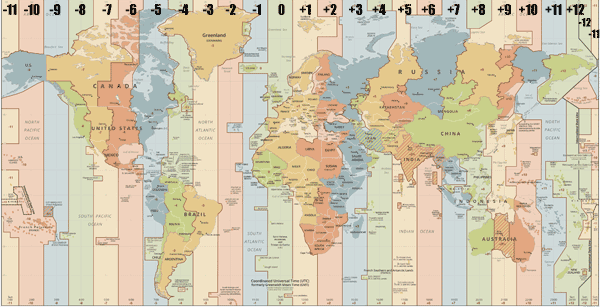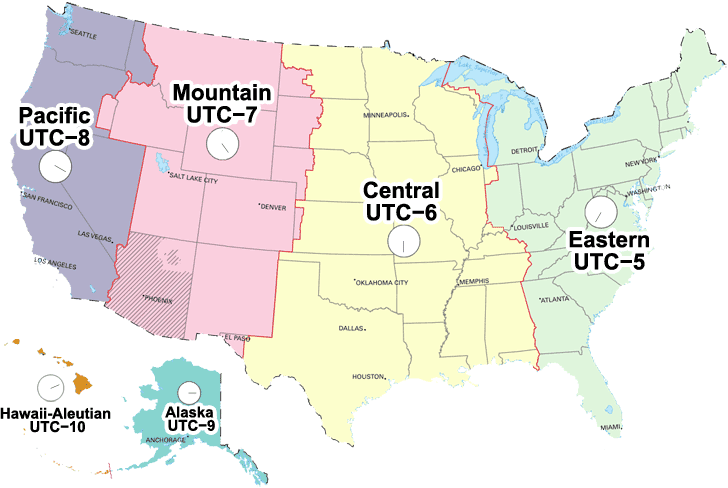Time zone
A time zone is a region of the Earth that follows a standard time, usually based on legal, commercial, and/or social reasons. While time zones generally change with respect to their longitude, they are not solely based on longitude; for example, a country could fit in a different time zone based on longitude, but may have close ties to a neighboring country such that using the same time zone would be beneficial. A country could also have borders that span multiple time zones, but be small enough that it would make more sense for the entire country to use a single time zone. Below is an example of a map showing the world's time zones:

Coordinated Universal Time (UTC)
UTC is the primary standard of time that has been used since 1961 to regulate clocks and time around the world. It is based on International Atomic Time, and is adjusted to be within 1 second of Universal Time, which is mean solar time at 0° longitude.
To understand mean solar time, we first need to understand solar time. Solar time bases the passage of time on the position of the sun in the sky. If looked from the earth, the sun doesn't travel at a uniform speed throughout the year, so solar days vary in length, meaning that time doesn't progress at a constant speed when using true solar time. Mean solar time uses the length of an average day (24 hours), so time progresses at a constant speed, allowing us to create standardized time systems, such as UTC.
UTC offset
UTC is the chosen time standard, and time zones around the world are expressed as an offset of UTC. Most are offset by a whole number of hours, but some are offset by 30 or 45 minutes.
A negative offset indicates that the time zone is west of 0° longitude. Similarly, a positive offset indicates a time zone east of 0° longitude. As an example, Central Standard Time is a timezone in the US that can be expressed as "UTC-06:00" or "UTC -6" while Japan Standard Time is expressed as "UTC+09:00" or "UTC +9." The time zone that uses UTC can be expressed as "UTC±00:00". UTC can also be denoted by the letter Z. For example, 10:30 AM in UTC can be written as "10:30 UTC" or "10:30Z."
Daylight saving time
Daylight saving time (DST) is a custom observed in certain countries or regions in which clocks are adjusted by an hour seasonally. The practice originated to make darkness occur later in the day (based on a clock). Typically, this involves adjusting clocks 1 hour forward at the beginning of spring, then adjusting them back 1 hour in the fall. By adjusting the clock forward, the sun effectively rises later and, more importantly, sets later. The rationale behind daylight saving time is that it would provide a person an extra hour of daylight after they've completed their daily activities, such as work or school.
UTC is not adjusted for daylight saving time. However, in time zones that do use daylight saving time, their offset relative to UTC changes throughout the year. For example, Central Standard Time (CST) is the time in a region of the US between fall and spring. Central Daylight Time (CDT) refers to the time in the same region during daylight saving time (spring and summer). Both these time zones cover the same region, but based on the time of year has an offset of UTC-05:00 (CDT) or UTC-06:00 (CST).
United States time zones
The US and its territories use a total of 9 time zones. 4 of these time zones cover the contiguous US, 2 of these cover Alaska and Hawaii, and the remaining 3 cover its territories.
Contiguous US time zones
Below are the 4 time zones for the contiguous US and their UTC offsets during daylight saving time and standard time. Almost the entire contiguous US observes daylight saving time, except for parts of Arizona.
- Eastern time zone - UTC-04:00 daylight saving time; UTC-05:00 standard time
- Central time zone - UTC-05:00 daylight saving time; UTC-06:00 standard time
- Mountain time zone - UTC-06:00 daylight saving time; UTC-07:00 standard time
- Pacific time zone - UTC-07:00 daylight saving time; UTC-08:00 standard time
Alaska and Hawaii
Hawaii and Alaska are the two US states that are not contiguous, and have their own time zones. While Alaska does observe daylight saving time, Hawaii has not since 1945.
- Alaska time zone - UTC-08:00 daylight saving time; UTC-09:00 standard time
- Hawaii-Aleutian time zone - UTC-10:00 standard time
US territories
The US territories include Puerto Rico, the U.S Virgin Islands, American Samoa, Guam, and the Northern Mariana Islands. There are a few other islands, but these exist outside the US time zones. None of the territories observe daylight saving time.
- Samoa time zone - UTC-11:00 standard time
- Chamorro time zone - UTC+10:00 standard time
- Atlantic time zone - UTC-04:00 standard time
Below is a map of the US time zones, not including the territories:

Converting UTC time zones
To convert between UTC time zones, use the following relationship:
(Zone A time) - (UTC offset A) = (Zone B time) - (UTC offset B)
Rearranging this relationship, we can see that:
Zone A time = (Zone B time) - (UTC offset B) + (UTC offset A)
The same is true for finding the time in Zone B.
Example
If it is 01:23 in Chicago, Illinois, which currently has an offset of UTC-05:00, what time is it in Auckland, New Zealand, which has an offset of UTC+12:00?
Zone A time: 01:23
Zone A offset: -06:00
Zone B time: ?
Zone B offset: +12:00
Plugging this into the formula:
Zone B time = (Zone A time) - (UTC offset A) + (UTC offset B)
Zone B time = 01:23 - (-05:00) + 12:00
Zone B time = 01:23 + 05:00 + 12:00 = 18:23
So it is currently 18:23 (6:23 pm) in Auckland, if it is 01:23 (1:23 am), in Chicago.
Note that the designation of Zone A or B is arbitrary and the answer would be the same regardless of which we called Zone A or B.
